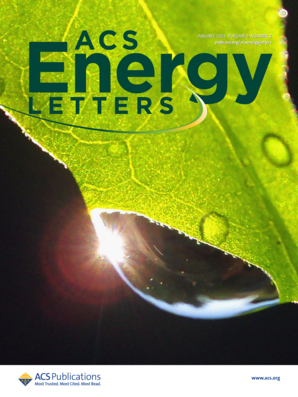分解锂金属电池气、液、固相电解质分解产物
IF 19.3
1区 材料科学
Q1 CHEMISTRY, PHYSICAL
引用次数: 0
摘要
具有高压阴极的锂(Li)金属电池是很有前途的下一代高能汽车电池。虽然醚基电解质以其高还原稳定性而闻名,但其对高压阴极的有限氧化稳定性仍然是长期使用寿命的关键障碍。在这里,我们提出了一种基于氟化1,2-二氧乙烷电解质和LiNiO2阴极模型的方法,可以全面、定量地评估阴极-电解质反应。不同温度下的在线电化学质谱通过量化气态副产物和反应活化能,揭示了电解质氧化分解的热力学和动力学特征。核磁共振波谱结果揭示醇和烷氧乙酸是醚电解质的可溶性分解产物。飞行时间二次离子质谱,结合兴趣区域和空间归一化标准偏差分析,定量地确定了阴极-电解质界面的厚度、空间和化学均匀性。这项工作建立了一个定量的方法来评估气态,可溶性和固体阴极电解质分解产物。本文章由计算机程序翻译,如有差异,请以英文原文为准。

Resolving Electrolyte Decomposition Products in Gas, Liquid, and Solid Phases in Lithium–Metal Batteries
Lithium (Li)-metal batteries with high-voltage cathodes are promising next-generation, high-energy automotive batteries. While ether-based electrolytes are known for their high reductive stability, their limited oxidative stability against high-voltage cathodes remains a key barrier to long-term service life. Here, we present a methodology enabling a comprehensive, quantitative assessment of cathode–electrolyte reactions, based on a model fluorinated 1,2-diethoxyethane-based electrolyte and LiNiO2 cathode. Online electrochemical mass spectroscopy at varying temperatures reveals both the thermodynamic and kinetic features of the electrolyte oxidative decomposition by quantifying gaseous byproducts and the reaction activation energy. Nuclear magnetic resonance spectroscopic results unveil alcohol and alkoxy acetic acid species as soluble decomposition products of ether electrolytes. Time-of-flight secondary ion mass spectrometry, combined with region-of-interest and spatial normalized standard deviation analyses, quantitatively determines the thickness and spatial and chemical homogeneity of the cathode–electrolyte interphase. This work establishes a quantitative methodology to assess gaseous, soluble, and solid cathode–electrolyte decomposition products.
求助全文
通过发布文献求助,成功后即可免费获取论文全文。
去求助
来源期刊

ACS Energy Letters
Energy-Renewable Energy, Sustainability and the Environment
CiteScore
31.20
自引率
5.00%
发文量
469
审稿时长
1 months
期刊介绍:
ACS Energy Letters is a monthly journal that publishes papers reporting new scientific advances in energy research. The journal focuses on topics that are of interest to scientists working in the fundamental and applied sciences. Rapid publication is a central criterion for acceptance, and the journal is known for its quick publication times, with an average of 4-6 weeks from submission to web publication in As Soon As Publishable format.
ACS Energy Letters is ranked as the number one journal in the Web of Science Electrochemistry category. It also ranks within the top 10 journals for Physical Chemistry, Energy & Fuels, and Nanoscience & Nanotechnology.
The journal offers several types of articles, including Letters, Energy Express, Perspectives, Reviews, Editorials, Viewpoints and Energy Focus. Additionally, authors have the option to submit videos that summarize or support the information presented in a Perspective or Review article, which can be highlighted on the journal's website. ACS Energy Letters is abstracted and indexed in Chemical Abstracts Service/SciFinder, EBSCO-summon, PubMed, Web of Science, Scopus and Portico.
 求助内容:
求助内容: 应助结果提醒方式:
应助结果提醒方式:


